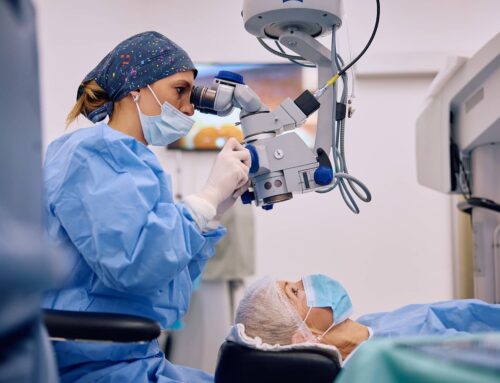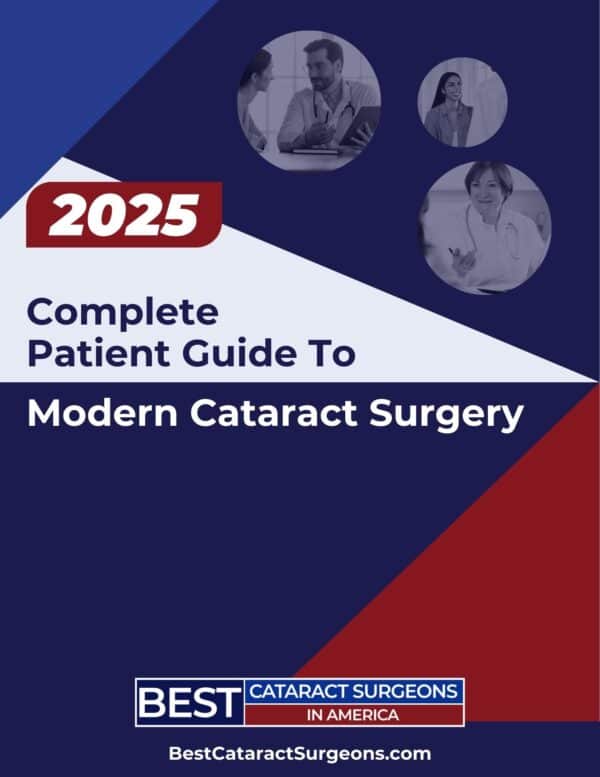Diabetes affects so many different areas of the body… the eyes are no exception. There are multiple different parts of the eye that diabetes can affect, most notably the retina and your natural lens. There are a number of things that patients who develop a cataract with diabetics should be aware of. In this article, we’re going to go over 7 special lessons that patients with diabetes should be aware of when it comes to cataracts.
1. Poor control of diabetes leads to earlier cataracts at a younger age
 Like many other problems caused by diabetes… if your blood sugar is poorly controlled, you risk developing complications from diabetes, including cataracts, at a younger age.
Like many other problems caused by diabetes… if your blood sugar is poorly controlled, you risk developing complications from diabetes, including cataracts, at a younger age.
No one wants to develop early cataracts and require surgery at a young age. This is particularly impactful to young adults who would otherwise enjoy a youthful & flexible natural lens until they get close to 50 years old and start to need reading glasses.
Fortunately, modern cataract surgery is very safe and effective… but the better path is to control your blood sugar well, which will delay the onset of cataracts.
2. Cataract from diabetes progresses faster
When a cataract develops from diabetes it is often a type called a “posterior subcapsular cataract”… or “PSC”. Unlike the more common age-related “nuclear sclerotic” cataracts, which progress very slowly… Diabetic PSC can progress rapidly.
In a “posterior subcapsular cataract”, the blurry part of your lens often starts right in the center. That means even when the cataract is early and just beginning, it already can be impactful to your vision.
Other types of cataracts can grow from the outside in, which takes longer to reach the center part of your vision. Therefore, these cataracts don’t progress as rapidly.
In some patients with diabetics, their cataracts can progress so quickly that the impairment to activities such as reading and driving seems to occur overnight.
Many different problems can cause vision loss. It’s important that you see your doctor immediately for any vision loss, especially sudden vision loss.
3. Diabetics are at higher risk of certain complications after surgery
Patients with diabetes can have damage to the blood vessels in the back part of the eye. The damage to the blood vessel wall causes the blood vessels to leak fluid and proteins into the retina.
This is a condition called “diabetic macular edema”.
Diabetic macular edema can result in vision loss. While there are treatments for it, vision loss can be serious and permanent.
After every cataract surgery, there is inflammation and swelling. In patients with damaged blood vessels from diabetes, these blood vessels can leak more resulting in swelling, or edema, in the retina after cataract surgery.
Diabetics are at more risk than non-diabetics to have this type of swelling in the retina after their cataract surgery. One of the best things to do to prevent this is to control your blood sugar and maintain a low A1c.
4. Diabetics may benefit from having cataract surgery sooner rather than later

The timing of when you should have cataract surgery should be a personalized discussion between you and your doctors. Whenever you’re making a personal medical decision, you want to consider the risks, benefits, and alternatives to that decision.
With cataract surgery, the risks and benefits may change over time. On one hand, no one wants to have surgery before it’s necessary… However, on the other hand, the risks of the procedure may go up if you wait.
There are a few ways that the risks of cataract surgery can increase the longer you wait…
First off, your cataract is not going to get better on its own. In fact, it’s going to continue gradually worsening. Blurry vision can make activities such as driving, working, and even walking, difficult. Patients with poor vision in even one eye can lose depth perception and balance.
In a study of falls and hip fractures, it was found that patients who had cataract surgery were less likely to have a hip fracture, presumably because patients with blurry vision were more likely to fall than patients who had clear vision after cataract surgery.
Secondly, as the cataract becomes more advanced, more energy is required to remove the cataract from your eye. This leads to increased swelling and inflammation after surgery. As a result, diabetic patients with more advanced cataracts are at more risk of developing macular edema (i.e. swelling in the center of the retina) after cataract surgery.
Having surgery on the sooner side can decrease the risks of these things, compared to waiting and having surgery then the cataract is more advanced, and your diabetes has had more time to cause leaky blood vessels in your retina.
5. Diabetics may benefit more from laser cataract surgery
A technique called “phacoemulsification” removes the cataract from patients’ eyes.
“Phacoemulsification” is a long word that basically means ultrasonic sound waves are used to break the hard cataract into small pieces or liquefy them. The liquified cataract is then suctioned out of your eye.
More ultrasound energy results in more swelling & inflammation after surgery and puts patients at more risk of having complications relating to swelling & inflammation.
Laser cataract surgery has been shown to decrease the amount of ultrasound energy needed to remove cataracts. The laser is able to break the cataract into small pieces, in a sense, softening it, so that less ultrasound energy is needed.
6. Diabetics can still benefit from modern lens implants
There are so many advanced lens implants today, and there is almost a perfect lens implant for everyone.
There are a few things diabetics should think about when considering their new lens implant.
We’d all like to be glasses-free for all our activities. Multifocal lens implants are a great way to achieve that goal after cataract surgery.

However, if you are a diabetic with macular edema or diabetic retinopathy that puts you at risk of developing macular edema in the future, multifocal implants may not be the best option for you. Macular edema can alter the quality of your vision, and when this occurs combined with the way multifocal implants can split and scatter light, it may not be the best combination.
On the other hand… if your diabetes is well controlled, and it hasn’t resulted in diabetic retinal disease, you may be a great candidate for multifocal implants.
What if you’re not a candidate for multifocal implants?… There are still many great options for you. For example, you may still be a candidate for a non-diffractive “extended depth of focus” implant that still gets you freedom from glasses and some intermediate or even near-range activities. Monovision or blended vision is another way to achieve freedom from glasses. Finally, the light adjustable lens may be a good option for you.
Modern lens implants can help diabetics reach their best vision without the need for glasses after surgery. However, it’s important to know that choosing a lens implant is not a “one-size-fits-all” situation. Work with an experienced surgeon to reach your vision goals.
7. Cataracts in diabetes can sneak up quickly and put your life at risk
Taking into account all of the things we’ve learned so far paints a picture in which cataracts can put your life at risk if not diagnosed and treated promptly.
Ask any eye doctor… We see it all the time…
Young adults who are diabetic can develop early cataracts that come on quickly. They’re a busy young adult with a job, a family, and other responsibilities… and as their vision becomes a little blurry, they delay coming to the doctor. Meanwhile, they still have to drive their car, and do their (sometimes dangerous job) with poor vision… Sometimes the vision is so bad that they aren’t legal to drive.
Accidents related to the blurry vision from cataracts are entirely preventable. If this article can convince just one of the many diabetes patients out there to have routine eye exams, and not delay if they notice blurry vision, it just might save a life…Maybe yours…Maybe a loved one…Or maybe the driver in the car next to you!
Conclusion
Following the tips above will put you on the path toward the best outcome possible when it comes to your cataracts. If you can only remember a few things… Most importantly for diabetics: Control your blood sugar… Have routine eye exams… and if your vision becomes blurry, see an eye doctor immediately.











